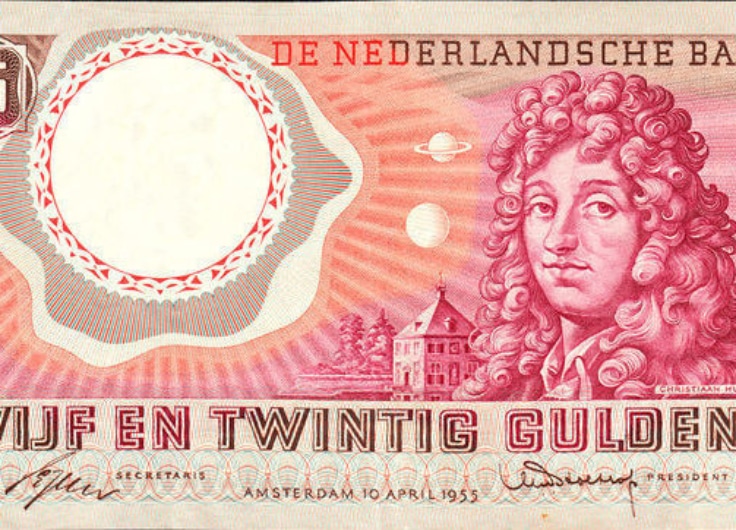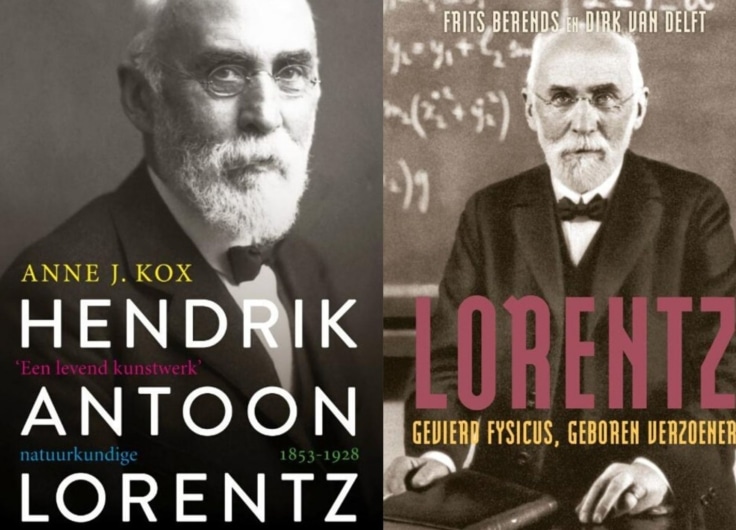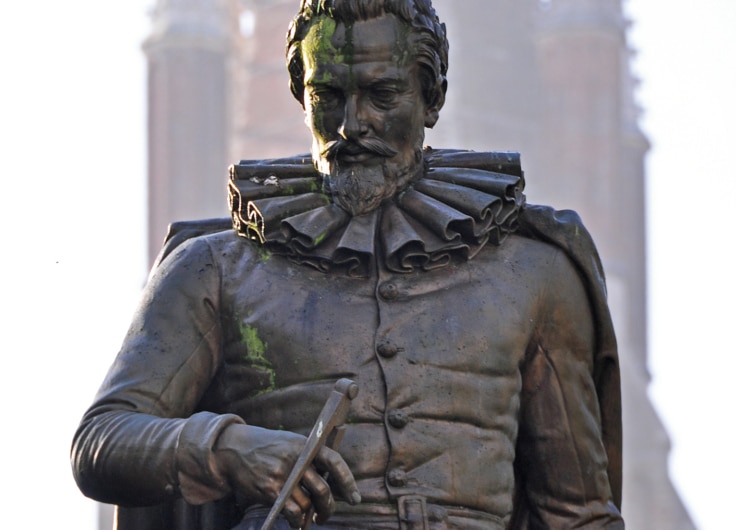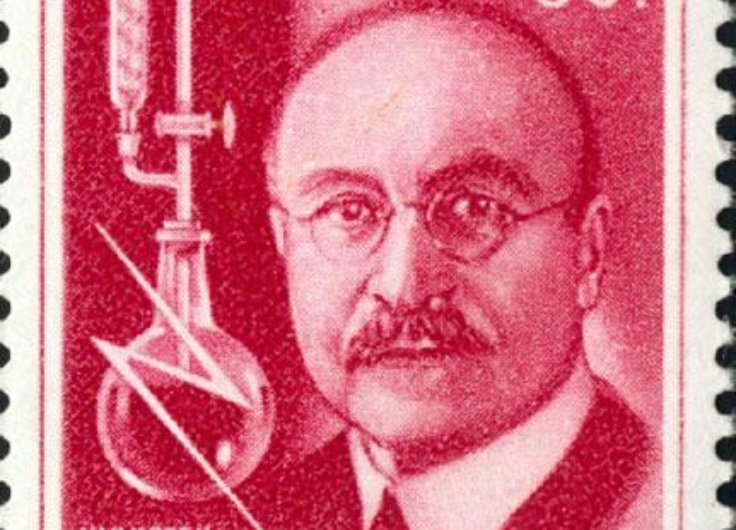Antoni van Leeuwenhoek, The Man Who Pushed the Borders of the Visible
The Dutch self-taught scientist Antoni van Leeuwenhoek died three hundred years ago. The anniversary of his death has led to books and an exhibition that shed light on the life of this wayward pioneer of microbiology – an important development even in an era full of scientific advancements. Van Leeuwenhoek’s story illustrates how great curiosity about the small things led to ground-breaking discoveries.
 Portrait of Anthonie van Leeuwenhoek (1632-1723) by Jan Verkolje
Portrait of Anthonie van Leeuwenhoek (1632-1723) by Jan Verkolje© Rijksmuseum Amsterdam
One way to understand the world better is to observe it more closely. But there is much that escapes perception either because it is too small or because it takes place in wavelengths that are invisible to us. To enhance their perception, scientists and inventors of the seventeenth century invented tools that overcame the limitations of the naked eye. One major step forward was the first microscope. Five pioneers opened the doors of the microworld: Robert Hooke and Nehemiah Grew in Britain, the Italian Marcello Malpighi and the Dutchmen Johannes Swammerdam and Antoni van Leeuwenhoek.
Swammerdam and Van Leeuwenhoek
Antoni van Leeuwenhoek was not the inventor of the microscope (as is sometimes incorrectly stated in texts), but he is regarded as the founder of microscopy. He distinguished himself from the other early inventors with higher magnifications and clearer images made possible by his experimentally developed combination of lens, microscope, lighting, choice of object and method of preparation.
Microscopy became the life work of both Swammerdam and Van Leeuwenhoek but, thanks to his exploration of the minuscule, it’s Van Leeuwenhoek who enjoys the greatest fame. How were they different? Swammerdam fell into a religious crisis, after which his scientific work declined. He also died young (from malaria), leaving his work unpublished for half a century. Van Leeuwenhoek, on the other hand, grew old (1632-1723) and gained substantial fame during his lifetime. Van Swammerdam was soon forgotten while Van Leeuwenhoek ended up in the top ten of the most famous Dutchmen of all time. The microscopes he manufactured manually, of which eleven have survived, are considered pieces of national heritage. He published in international journals and was a member of the renowned Royal Society in London.
Antoni van Leeuwenhoek was not the inventor of the microscope, but he is regarded as the founder of microscopy
The similarities and differences between the two pioneers of the barely visible were meticulously reconstructed in 2022 by Eric Jorink in his contribution to Fascinerend leven, de onvolprezen geschiedenis van de biologie (Fascinating Life, the Unsurpassed History of Biology) edited by Johan Braeckman and Linda Van Speybroeck. Jorink describes how resourceful both of the brilliant seventeenth-century scientists were and how, thanks to their great perseverance and the help of self-made microscopes, they shed a whole new light on the very smallest of life forms. They saw things no one had seen before, such as the guts of insects, red blood cells and sperm cells.
Swammerdam was fluent in many languages, while Van Leeuwenhoek spoke and wrote only Dutch – in a very idiosyncratic style. Swammerdam travelled throughout Europe; van Leeuwenhoek hardly ever left his hometown of Delft. Swammerdam viewed the world from a strict, Cartesian frame of mind; Van Leeuwenhoek described what he saw. Swammerdam was a driven and lyrical prophet, Van Leeuwenhoek a level-headed surveyor.
Famous
The teenage Thonis (later Antoni) van Leeuwenhoek became an apprentice to a cloth merchant, where he learned to work with magnifying glasses to check the structure and quality of fabrics. Additionally, he served as chamberlain for the assembly chamber of the Delft sheriffs, where his tasks included land surveyor, official “wine-gauger” (testing imports and exports) and executor of wills (in the latter position, for example, he managed Vermeer’s legacy).
As a bookkeeper, the self-taught scientist was meticulous. Around 1670 he started making microscopes: small drop-shaped lenses of molten glass, the strongest of which magnified up to two hundred and seventy times. He looked at everything he encountered through those microscopes: pieces of plants and wood, blood, semen, hair, saliva, dental tartar, faeces, milk, ditch water and insects.
 Sketches of insects, creatures from ditch water and grains of sand as Antoni van Leeuwenhoek saw them through his lenses.
Sketches of insects, creatures from ditch water and grains of sand as Antoni van Leeuwenhoek saw them through his lenses.© Royal Society, Londen / Rijksmuseum Boerhaave, Leiden
He was nominated as a member of the Royal Society and published his findings in Philosophical Transactions, the world’s first scientific journal. The importance of this monthly publication, which formed a platform for Van Leeuwenhoek’s observations, cannot be overstated. His images of microscopic observations reached a wide audience of scholars and other interested parties. The Society focused on empiricism and experimentation, which dovetailed neatly with Van Leeuwenhoek’s method of collecting facts combined with his deep speculations. Despite much insistence, Van Leeuwenhoek never revealed the secret of his microscopes.
Despite much insistence, Van Leeuwenhoek never revealed the secret of his microscopes
After joining the Royal Society, Van Leeuwenhoek’s fame spread far beyond the national borders and he was visited at home by inquisitive monarchs and scholars. While he was flattered by their interest, he was also irritated by all the disturbing interruptions. This and much more is discussed in great detail in Onzichtbaar leven (Invisible Life) by Dirk van Delft, known for his acclaimed biography of the Dutch physicist and Nobel Prize winner Hendrik Lorentz. Van Delft loses himself here and there in the complexity of the social history of the seventeenth century, and the surprising amount of scheming between competing scientists. In combination with chronological triple jumps and an abundance of literal quotes, this results in a challenging book that will primarily appeal to interested readers who can bring great perseverance to the task.
A cell in front of the lens
In a letter dated 9 October 1676, Van Leeuwenhoek described miniscule creatures living in rainwater: “animals that were ten thousand times smaller” than the water flea. For the first time in human history, he had observed single-celled microorganisms, a previously unimaginable form of life. Keeping his tools and methods secret prevented others from replicating his observations, so his findings were not taken entirely seriously at first. It would be another year before others were able to observe the animals as well. Only then did a wonderful new world open up for research. Bacteria and protozoa became as real as rabbits or beeches.
In November 1677, Van Leeuwenhoek sent another report of an astonishing and controversial discovery to London. He had seen spermatozoa in male semen. It would be another two years (and many experiments with rabbit, dog and horse semen) before the Society dared to publish his findings alongside accompanying illustrations.
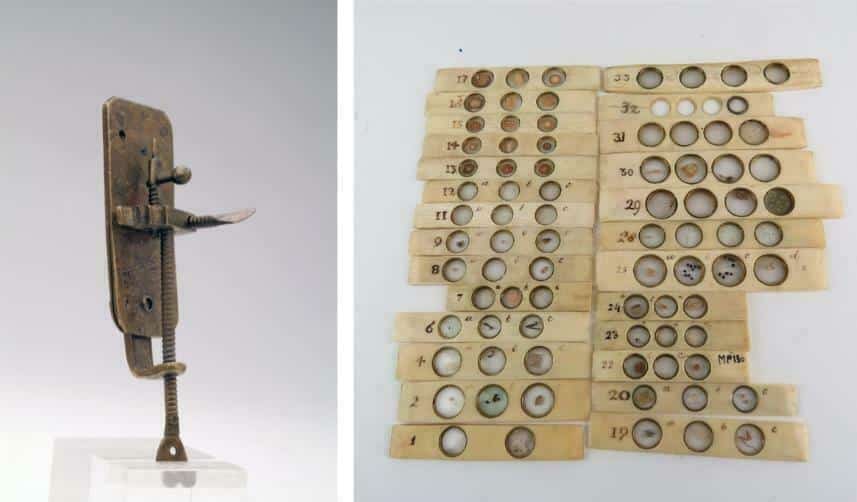 A microscope of Antoni van Leeuwenhoek and the type of specimens he used for his research.
A microscope of Antoni van Leeuwenhoek and the type of specimens he used for his research.© Rijksmuseum Boerhaave, Leiden
Those images were crucial to understanding in the day and are also very interesting from a science-historical and philosophical point of view. What did Van Leeuwenhoek and colleagues see through those first primitive lenses? Fixing preparations and focusing on them required prodigious skill and, even then, only a fragment of the preparation could be clearly seen. Depending on the lighting, other things came into view. Moreover, people were looking at things that no one had ever seen or described before, so they had no frame of reference.
According to Van Leeuwenhoek, a man who wants to find new things should not rely on one observation but look many times
If Van Leeuwenhoek and his colleagues made drawings of what they saw, those images would have been composite image of fragments observed in different observations. Or as historian Geertje Dekkers writes in her very readable, lively, complete and yet concise biography Veel, klein en curieus
(Many, Small and Curious): “For Antoni, who had to invent a lot himself and did not know what he was looking for, that must have been difficult. Hence, he was sometimes mistaken in what he saw, which is why he gave this sage advice to the Royal Society: ‘a man who wants to find new things should not rely on one observation but look many times.’”
This quandary is still relevant today: how does one look for a needle in a haystack if he doesn’t know what a needle looks like? What we see is determined just as much by the lighting and magnification as by our expectations.
And behold: the invisible
In her book, Dekkers relies heavily on the work of an international research consortium that, in 2023, the year of Antoni van Leeuwenhoek, has reconstructed the observations made by him and fellow microscopists, with the theme of Visualizing the Unknown. How did they make their lenses? How and what exactly did they see? And how did they perfect their viewing skills? This resulted in the beautiful – for both viewing and reading – book Antoni van Leeuwenhoek en de microwereld (Antoni van Leeuwenhoek and the Microworld). There is a lot to see here: one of the main authors is micro photographer Wim van Egmond, who used the latest digital camera techniques to look at the same preparations through the original microscopes, just as Van Leeuwenhoek did.
The book is the prelude to the Onvoorstelbaar (Unimaginable) exhibition in Leiden, which shows invisible worlds but also how the pioneers of the time had to develop a new formal language to understand, record and communicate about their finds. The first microbiologists were exploring unknown territory. Their work laid a pragmatic foundation for the scientific research method we know today, in which instruments and techniques determine theory and observation, and vice versa.
Today, microbiology has proved invaluable in identifying and solving important issues in the fields of health, nutrition, climate and energy. Macro-scale problems have become more solvable thanks to the knowledge of the micro-level of life.
Three years after the outbreak of the corona pandemic, it is well worth remembering that three hundred years ago no one would have had the faintest idea of what was happening to us. Yet, despite having learned a great deal about the processes of life and death in the meantime, the field of microbiology engenders a sense of humility about how much we really (don’t) know about the precise functioning of metabolism, disease, consciousness or aging at the cellular level. Every scientific step forward we make, every day, is only possible because we stand on the shoulders of giants; in Van Leeuwenhoek’s case, a curious, clever and enterprising explorer of the invisible.
Unimaginable. How Van Leeuwenhoek’s microscope changed the world, exhibition at Rijksmuseum Boerhaave, Leiden, until 7 Januari 2024.
Books (in Dutch)
- Johan Braeckman and Linda Van Speybroeck (eds.), Fascinerend leven. Een geschiedenis van de biologie, Academia Press, Gent, 2022, 742 pp.
- Geertje Dekkers, Veel, klein en curieus. De wereld van Antoni van Leeuwenhoek (1632-1723), Spectrum, Amsterdam, 2023, 214 pp.
- Sietske Fransen and Tim Huisman (eds.), Antoni van Leeuwenhoek en de microwereld, WBooks, Zwolle, 2023, 128 pp.
- Dirk van Delft, Onzichtbaar leven. Antoni van Leeuwenhoek en de wondere wereld van de microbiologie, Prometheus, Amsterdam, 2022, 312 pp.




